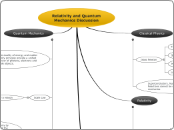jonka James Bell 13 vuotta sitten
1103
Relativity and Quantum Mechanics Discussion

jonka James Bell 13 vuotta sitten
1103

Lisää tämän kaltaisia
The other theory presented by Einstein says that probabilities show our inability to describe quantum mechanics. But it is pointless to say that it does not exist alltogether. We study what we can describe and observe
One theory says that this means the universe is indeterministic
This is why we use probabilities
When you look at something, the photon exchange from your eyes to the object can alter the results. We are talking SMALL here. VERY SMALL
Heisenberg's Uncertainty Principle
Double-Slit Difraction
Observation?
When the experiment is observed/measured the particles act as classical physics would describe.
Photons are fired at a sheet with two slits in it
Once fired, they should produce two lines on the screen behind it, right?
Wrong. They produce a wave interference pattern
the double-slit experiment demonstrates the inseparability of the wave and particle natures of light and other quantum particles
Schrodinger's Cat
Modern Physics Induces Skepeticism
A cat, along with a flask containing a poison and a radioactive source, is placed in a sealed box shielded against environmentally induced quantum decoherence. If an internal Geiger counter detects radiation, the flask is shattered, releasing the poison that kills the cat. The Copenhagen interpretation of quantum mechanics implies that after a while, the cat is simultaneously alive and dead. Yet, when we look in the box, we see the cat either alive or dead, not both alive and dead.
One cannot know both the position and momentum of a particle simultaneously
describes the probability amplitude of the position and momentum of a particle.
Color Patterns
Quantum realm particles are bizzare because they are VERY small
Human bones are proportional to distribute the weight
Beached Whales die because they are crushed by their own weight
Nobody really understands quantum theory
The Universe is expanding, and the far parts of it are moving away from us faster than the speed of light.
Balloon Analogy
Rotating masses "drag along" the spacetime around them; a phenomenon termed "frame-dragging".
Rays of light bend in the presence of a gravitational field.
Clocks run more slowly in regions of lower gravitational potential. This is called gravitational time dilation.
Moving clocks are measured to tick more slowly than an observer's "stationary" clock.
Objects are measured to be shortened in the direction that they are moving with respect to the observer.
E=mc^2
We cannot travel faster than the speed of light. At that point our mass essentially becomes energy. We would then exhibit wave-particle properties
Two events, simultaneous for one observer, may not be simultaneous for another observer if the observers are in relative motion.
Train Paradox in More Detail
The speed of light in a vacuum is the same for all observers, regardless of their relative motion or of the motion of the source of the light.
The laws of physics are the same for all observers in uniform motion relative to one another (principle of relativity),